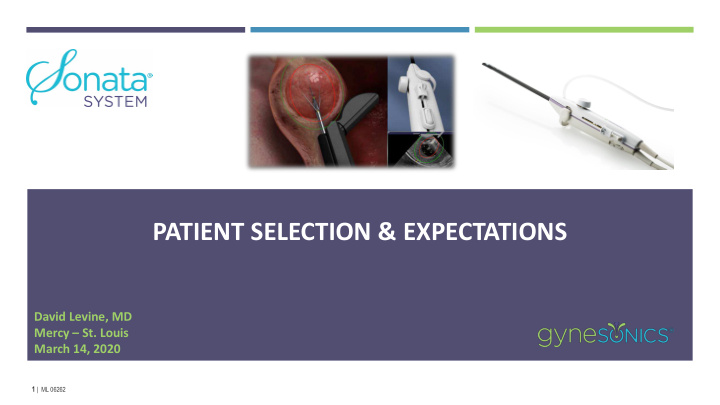



PATIENT SELECTION & EXPECTATIONS DIPAK DELVADIA, DO VIRTUA OB/GYN VOORHEES, NJ David Levine, MD Mercy – St. Louis March 14, 2020 1 | ML 06262
Sonata Contraindications Active pelvic infection Presence of one or more intra-tubal (intrauterine) implants for sterilization Presence of an intrauterine device (IUD), unless removed prior to the introduction of the Sonata treatment device. Known or suspected gynecologic malignancy or premalignant disorders such as EIN - endometrial intraepithelial neoplasia (atypical endometrial hyperplasia) Current pregnancy 2 | ML 06262
Patient Selection Considerations Fibroid size Published experience includes fibroids 7-8 cm 80% of fibroids treated were 1-4cm Fibroids ≥ 6 cm require multiple ablations to optimize volume reduction Number of fibroids - up to 10 fibroids were ablated/patient during the SONATA Trial The average number of fibroids treated was 3.5 per patient in the SONATA Trial Safety and effectiveness regarding fertility and fecundity after the use of the Sonata System have not been established Effectiveness in women with clinically significant adenomyosis has not been established Other conditions as stated in the Sonata System Operator’s Manual 3 | ML 06262
Fibroid Size and Volume RF ablation is volumetric Assume sphere where V = 4/3 π r 3 An 8-cm myoma = 268.1 cc but a 9-cm myoma = 381.7 cc (42.4% increase) 5 cm x 4 cm Sonata ablation (largest size) = 41.9 cc 4 | ML 06262
Diameter vs. Volume 5 | ML 06262
Patient Selection: Considerations for New Users Ideal patient selection for new Sonata users: Primary target of Type 1, 2 or 3 myoma ≤6 cm in diameter • Higher likelihood of success/symptom improvement • Fibroid associated with HMB, • Ability to target • Treat fibroid with single ablation • Associated with increased safety margin between fibroid and serosa Limited number of fibroids to treat, preferably no more than 3 fibroids Avoid patients presenting with isolated subserous fibroids 6 | ML 06262
Patient Expectations Setting appropriate expectations is critical to avoiding patient regret and need for potentially-avoided surgical reintervention Most patients will see improvement in HMB within 3 months The goal is meaningful improvement in symptoms This may or may not meet the definition of eumenorrhea (≤ 80 cc MBL) Important for patients to not expect Amenorrhea (this is not endometrial ablation) Immediate results Patients should be counselled about potential fibroid sloughing It can result in intermenstrual spotting Refer to the Operator’s Manual for additional counselling 7 | ML 06262
Perioperative Care Bladder drainage not mandatory for imaging but helpful for patient comfort Always best for patient to void on her own just before TFA Antibiotics? As with operative hysteroscopy, no clear need except for other indications (eg, SBE) In SONATA, 0.7% of patients received prophylaxis General Anesthesia not required but may be indicated for specific patients Better to have proper airway control if deep sedation is needed for pain control Postop Patients typically on NSAIDs Similar expected events to operative hysteroscopy (leukorrhea x days, spotting, cramping) Postop visit or call as per your customary practice 8 | ML 06262
Some Potential Challenges Small lower uterine segment myoma Need 2.3 cm of space for minimum ablation size Large / firm (calcified) myoma Cervical stenosis Take extra care to verify intrauterine entry! Marked anteflexion/retroflexion 9 | ML 06262
Lower Uterine Segment Ablations Need ≥ 2.3 cm Serosa Serosa • Minimum of 2.3 cm distance between endometrial surface and uterine serosa • Smallest ablation size is 2.2 cm x 1.5 cm 10 | ML 06262
Learn more at SonataTreatment.com THANK YOU! 11 | ML 06262
Recommend
More recommend